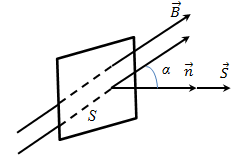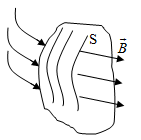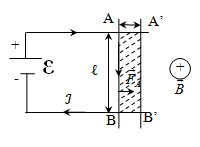main
To the list of lectures
|
§8 The Hall effect
Ux=RjhB Hall potential difference Ux depends on the material of the plate, the current density
Explanation of the Hall effect can be given in terms of the classical electron theory of metals. FL = FEl, qvB = qE, vB = E,
S = hd,
Hall coefficient R is inversely proportional to the charge and the charge carrier concentration.
a) for the measurement of the magnetic field B. b) for the measurement of high amperage 103 ÷ 106 A. c) in cars. 4. Keyboard to PC
§ 10 Flux of magnetic induction. Gauss’s theorem for the magnetic field Consider a uniform magnetic field with magnetic induction
Flux of magnetic induction can be positive or negative depending on the sign of Magnetic flux is measured in Weber
1 Weber - is the magnetic flux generated by the magnetic field with the induction of 1 T over an area of ??1 m2. In the case of non-uniform field is considered an elementary stream through an elementary area dS.
Then the total magnetic flux is equal to the integral of the square S
2. Because lines of force of vector
§ 11 The work on moving current-carrying conductor in a magnetic field Consider the contour containing the EMF has such a feature: the conductor AB can move freely. Circuit is placed in a uniform magnetic field directed perpendicular to the figure for the square ??the circuit. On current-carrying conductor in a magnetic field experiences a force Ampere
This force moves the conductor AB on Δх. Then the work of Ampere force on the movement of the conductor on Δх is equal to
The work done
in moving the current-carrying conductor in a magnetic field is
determined by the product of the current flowing through a conductor,
the change of the magnetic flux. And the change of the magnetic flux
is determined by the product of the magnetic induction
MAGNETIC FIELD IN MATTER § 1 the Magnetic moments of electrons and atoms. Microcurrents. Magnetization Magnetic materials are substances that can acquire an external magnetic field magnetic properties - magnetized, ie create their own magnetic field. Explain the magnetization of matter by using Ampere's hypothesis: the motion of electrons in atoms and molecules leads to the (existence) of the elementary currents, called microcurrents. We can assume that the electron in an atom moves in a circular orbit. This is equivalent to a circular motion of the electron current
where ν –frequency of rotation of the electron , е –electron charge . Velocity of the particle can be associated with the frequency by ratio
therefore ,
The magnetic moment of the electron moving around the nucleus (orbital magnetic moment) is
Electron along with the magnetic moment has an orbital mechanical angular momentum
Gyromagnetic ratio g
The minus sign indicates that the Electron,
in addition behaves as if constantly rotates around its own axis. This
property is called electron spin. Spin - an intrinsic property of the
particle in the same intrinsic electron, as well as mass and charge.
Therefore, the electron is assigned its own angular momentum (spin)
Spin has only two projections on the direction of the magnetic field
where g - the gyromagnetic ratio of the spin moments. The magnetic moment of the atom - the value of the total
Moreover, this value is quite difficult to give due consideration, the numerical values ??of the magnetic moments of individual particles as well as their direction. The magnetic moments of protons and neutrons is much smaller magnetic moments of electrons. Therefore, their magnetic moments can be neglected in comparison with the magnetic moments of electrons and we can assume that the magnetic properties of an atom are determined mainly by the magnetic properties of electrons. Because electrons are part of all atoms, this means that the magnetic field will have an effect on any substance, therefore, non-magnetic materials do not exist. Each electron behaves as an elementary magnet. Therefore, making the body in a magnetic field should affect the configuration of the field and, conversely, the presence of a magnetic field will affect the behavior of matter. The magnetic field of all the bodies are magnetized, ie elementary volume of the body acts as the magnet and the magnetic moment of the body is the sum of the magnetic moments of the volume elements. To estimate the intensity of magnetization of the body treated magnetic moment per unit volume – magnetization
N – total number of atoms in a small volume
|





